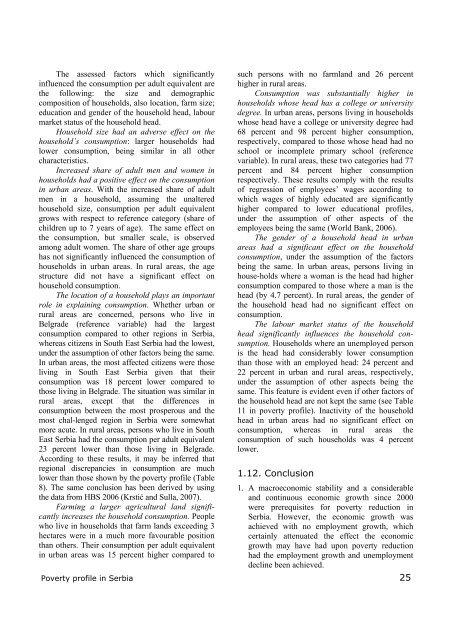Living Standards Measurements Study - Serbia 2002 - 2007
Living Standards Measurements Study - Serbia 2002 - 2007
Living Standards Measurements Study - Serbia 2002 - 2007
You also want an ePaper? Increase the reach of your titles
YUMPU automatically turns print PDFs into web optimized ePapers that Google loves.
The assessed factors which significantly<br />
influenced the consumption per adult equivalent are<br />
the following: the size and demographic<br />
composition of households, also location, farm size;<br />
education and gender of the household head, labour<br />
market status of the household head.<br />
Household size had an adverse effect on the<br />
household’s consumption: larger households had<br />
lower consumption, being similar in all other<br />
characteristics.<br />
Increased share of adult men and women in<br />
households had a positive effect on the consumption<br />
in urban areas. With the increased share of adult<br />
men in a household, assuming the unaltered<br />
household size, consumption per adult equivalent<br />
grows with respect to reference category (share of<br />
children up to 7 years of age). The same effect on<br />
the consumption, but smaller scale, is observed<br />
among adult women. The share of other age groups<br />
has not significantly influenced the consumption of<br />
households in urban areas. In rural areas, the age<br />
structure did not have a significant effect on<br />
household consumption.<br />
The location of a household plays an important<br />
role in explaining consumption. Whether urban or<br />
rural areas are concerned, persons who live in<br />
Belgrade (reference variable) had the largest<br />
consumption compared to other regions in <strong>Serbia</strong>,<br />
whereas citizens in South East <strong>Serbia</strong> had the lowest,<br />
under the assumption of other factors being the same.<br />
In urban areas, the most affected citizens were those<br />
living in South East <strong>Serbia</strong> given that their<br />
consumption was 18 percent lower compared to<br />
those living in Belgrade. The situation was similar in<br />
rural areas, except that the differences in<br />
consumption between the most prosperous and the<br />
most chal-lenged region in <strong>Serbia</strong> were somewhat<br />
more acute. In rural areas, persons who live in South<br />
East <strong>Serbia</strong> had the consumption per adult equivalent<br />
23 percent lower than those living in Belgrade.<br />
According to these results, it may be inferred that<br />
regional discrepancies in consumption are much<br />
lower than those shown by the poverty profile (Table<br />
8). The same conclusion has been derived by using<br />
the data from HBS 2006 (Krstić and Sulla, <strong>2007</strong>).<br />
Farming a larger agricultural land significantly<br />
increases the household consumption. People<br />
who live in households that farm lands exceeding 3<br />
hectares were in a much more favourable position<br />
than others. Their consumption per adult equivalent<br />
in urban areas was 15 percent higher compared to<br />
Poverty profile in <strong>Serbia</strong><br />
such persons with no farmland and 26 percent<br />
higher in rural areas.<br />
Consumption was substantially higher in<br />
households whose head has a college or university<br />
degree. In urban areas, persons living in households<br />
whose head have a college or university degree had<br />
68 percent and 98 percent higher consumption,<br />
respectively, compared to those whose head had no<br />
school or incomplete primary school (reference<br />
variable). In rural areas, these two categories had 77<br />
percent and 84 percent higher consumption<br />
respectively. These results comply with the results<br />
of regression of employees’ wages according to<br />
which wages of highly educated are significantly<br />
higher compared to lower educational profiles,<br />
under the assumption of other aspects of the<br />
employees being the same (World Bank, 2006).<br />
The gender of a household head in urban<br />
areas had a significant effect on the household<br />
consumption, under the assumption of the factors<br />
being the same. In urban areas, persons living in<br />
house-holds where a woman is the head had higher<br />
consumption compared to those where a man is the<br />
head (by 4.7 percent). In rural areas, the gender of<br />
the household head had no significant effect on<br />
consumption.<br />
The labour market status of the household<br />
head significantly influences the household consumption.<br />
Households where an unemployed person<br />
is the head had considerably lower consumption<br />
than those with an employed head: 24 percent and<br />
22 percent in urban and rural areas, respectively,<br />
under the assumption of other aspects being the<br />
same. This feature is evident even if other factors of<br />
the household head are not kept the same (see Table<br />
11 in poverty profile). Inactivity of the household<br />
head in urban areas had no significant effect on<br />
consumption, whereas in rural areas the<br />
consumption of such households was 4 percent<br />
lower.<br />
1.12. Conclusion<br />
1. A macroeconomic stability and a considerable<br />
and continuous economic growth since 2000<br />
were prerequisites for poverty reduction in<br />
<strong>Serbia</strong>. However, the economic growth was<br />
achieved with no employment growth, which<br />
certainly attenuated the effect the economic<br />
growth may have had upon poverty reduction<br />
had the employment growth and unemployment<br />
decline been achieved.<br />
25















